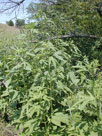GIANT RAGWEED
|
 |
| File Size: 76 KB |
|
|
|
Ambrosia trifida L.
|
| Johnson County, Kansas |
| Annual |
| Height: 3-13 feet |
| Family: Asteraceae - Sunflower Family |
| Flowering Period: August, September,October |
|
| Stems: | | Erect, usually simple or sparingly branched above, longitudinal ridges, rough, short-hairy. | | Leaves: | | Mostly opposite, uppermost often alternate, simple, rough; stalks .4 to 2.8 inches long; blades of lower and middle leaves egg-shaped to nearly circular in outline, 4 to 8 inches long, 1.2 to 7.8 inches wide, usually palmately 3- to 5-cleft; margins usually toothed; upper surface somewhat spreading-hairy; lower surface nearly smooth; upper leaves smaller, 3-cleft to nearly entire. | | Inflorescences: | | Monoecious (staminate and pistillate heads occur at different locations on same plant); heads of staminate florets in racemes, elongated, to 6 inches long, panicle-like, terminal; heads of pistillate florets in clusters in axils of bracts below staminate inflorescences. | | Flowers: | | Greenish-yellow; staminate heads short-stalked, saucer-shaped, 1/12 to 1/6 inch across, 6-8-lobed; florets 3-25+; pistillate heads with egg-shaped involucre, about 1/6 inch long, 1-flowered. | | Fruits: | | Bur-like, pyramidal, 1/5 to 1/3 inch long, hard, formed by floral bracts, glabrous or sparsely-hairy; beak 1/25 inch long, surrounded by 4-8 blunt spine-like projections; seed 1, small. | | Habitat: | | Moist disturbed sites, stream banks, roadside ditches, margins of ponds and lakes, old fields, waste areas, pastures. | | Distribution: | | Throughout Kansas | | Origin: | | Native | | Reproduction: | | By seeds | | Forage Value: | | Unpalatable for livestock, though horses will sometimes eat it. Deer eat the leaves and pheasants, quail, prairie chickens, and songbirds eat the fruits. | | Uses: | | Native Americans rubbed crushed leaves on insect bites and steeped the leaves to make a tea taken for fevers and pneumonia and used as a wash for hives. The root was chewed to alleviate fear at night. Stem fibers were used as thread. Giant ragweed provides wildlife cover. | | Comments: | | Giant ragweed is highly variable. It is wind pollinated and is a major cause of allergy symptoms in the fall. It will form colonies in disturbed areas. Can be a problem weed in cultivated fields. |
|
| Giant ragweed inflorescence |  | | 72 KB | | Riley County, Kansas |
| | Giant ragweed staminate inflorescence |  | | 68 KB | | Riley County, Kansas |
| | Giant ragweed |  | | 60 KB | | Riley County, Kansas |
| | Giant ragweed |  | | 180 KB | | Riley County, Kansas |
| | Giant ragweed leaves |  | | 96 KB | | Johnson County, Kansas |
| | Giant ragweed |  | | 132 KB | | McPherson County, Kansas |
| | Giant ragweed |  | | 128 KB | | Ellsworth County, Kansas |
| | Giant ragweed |  | | 111 KB | | Ellsworth County, Kansas |
| | Giant ragweed inflorescence |  | | 56 KB | | Konza Prairie, Riley County, Kansas |
| | Giant ragweed inflorescences |  | | 85 KB | | Riley County, Kansas |
|
|
|
|
|
|
|